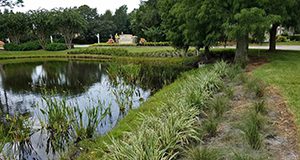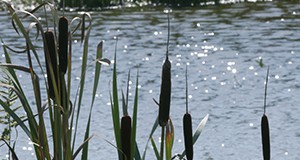Stormwater ponds play critical roles for flood control and water quality treatment, and they can provide ecological services to communities. Those ecological services can be enhanced with proper pond design and maintenance. This 6-page fact sheet written by Gisele P. Nighswander, Mary E. Szoka, Kayla M. Hess, Eban Z. Bean, Gail Hansen de Chapman, and Basil V. Iannone III and published by the UF/IFAS School of Forest Resources and Conservation provides a comprehensive database of plant traits to help readers make informed stormwater pond plant selection decisions based on their own relative priorities.
http://edis.ifas.ufl.edu/fr416
Tag: Gail Hansen de Chapman
Strategies to Encourage Adoption of Stormwater Pond Best Management Practices (BMPs) by Homeowners
Man-made ponds can be a useful way to collect, store, and treat stormwater runoff in residential areas. However, these ponds can become polluted when runoff contains fertilizers, pesticides, and pet waste from the neighborhood. This 8-page fact sheet outlines several best management practices (BMPs) for reducing stormwater pond pollution. Based on a survey of residents who live near stormwater ponds, the authors recommend strategies Extension educators can use to encourage residents to adopt these BMPs. Written by Emily Ott, Paul Monaghan, Ondine Wells, Gail Hansen, Laura Warner, and Michelle Atkinson, and published by the UF Department of Agricultural Education and Communication, July 2015.
http://edis.ifas.ufl.edu/wc214
A Manual for the Design and Implementation of Teaching and Demonstration Gardens
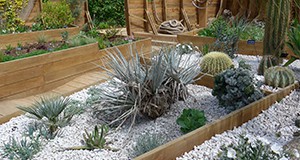
Teaching and demonstration gardens are places where the public can learn about different types of gardens and landscapes. This 10-page fact sheet discusses the various types of gardens, how to plan and develop a demonstration garden, logistical and design considerations, and educational programming. Written by Gail Hansen, and published by the UF Environmental Horticulture Department, July 2015.
http://edis.ifas.ufl.edu/ep524
Perceptions of Florida-Friendly Landscapes: Linking Visual Quality and Environmental Health through Landscape Codes
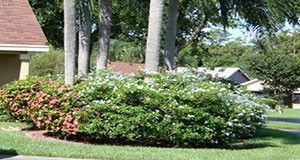
Early efforts to promote Florida-Friendly landscapes emphasized the use of drought-tolerant plants, which created a negative association with a visually unappealing landscape. This has hampered the promotion of FFL yards and the adoption by homeowner associations. But recently many homeowners are rethinking their landscape maintenance and plant choices and HOAs are considering promoting environmentally friendly landscapes but express uncertainty about recommending FFL because of the need to maintain visual quality. We conducted a study to address both groups’ concerns and help develop FFL-oriented landscape codes that meet both groups’ needs. This 7-page fact sheet was written by Gail Hansen, Laura Warner, Paul Monaghan, Emily Ott, Tim Fogarty, Claire Lewis, and Esen Momol, and published by the UF Department of Environmental Horticulture, April 2015.
http://edis.ifas.ufl.edu/ep519
Ten Strategies for Working With Your Home Owner Association to Convert to a Florida-Friendly Yard
 Many homeowners are beginning to rethink their landscapes for several reasons, including mandated water and fertilizer restrictions, increasing maintenance costs, and concern for the environment. But over sixty million people now live in neighborhoods governed by Homeowner Associations, whose regulations can make it difficult to implement some changes by mandating types of plants, percentages of turf and plant material, location of plant materials, and restricting specialty gardens to back yards. More environmentally sound landscapes are possible with careful planning and design and by using an educated and knowledgeable approach to working with the HOA board to gain approval for a new landscape. This 9-page fact sheet offers several strategies for working within HOA regulations to gain approval for a Florida-Friendly landscape. Written by Gail Hansen and Claire Lewis, and published by the UF Department of Environmental Horticulture, February 2015. (Photo credit: Florida-Friendly Landscaping™ Program)
Many homeowners are beginning to rethink their landscapes for several reasons, including mandated water and fertilizer restrictions, increasing maintenance costs, and concern for the environment. But over sixty million people now live in neighborhoods governed by Homeowner Associations, whose regulations can make it difficult to implement some changes by mandating types of plants, percentages of turf and plant material, location of plant materials, and restricting specialty gardens to back yards. More environmentally sound landscapes are possible with careful planning and design and by using an educated and knowledgeable approach to working with the HOA board to gain approval for a new landscape. This 9-page fact sheet offers several strategies for working within HOA regulations to gain approval for a Florida-Friendly landscape. Written by Gail Hansen and Claire Lewis, and published by the UF Department of Environmental Horticulture, February 2015. (Photo credit: Florida-Friendly Landscaping™ Program)
http://edis.ifas.ufl.edu/ep513
Florida-Friendly Plants for Stormwater Pond Shorelines (ENH1215/EP476)
 Selecting aquatic and shoreline plants for stormwater ponds is more challenging than selecting plants for a typical landscape. Site conditions can vary greatly and are more difficult to control. For example, water depth sometimes fluctuates widely, creating wet and dry conditions. Water quality varies with rainfall and fertilizer inputs. Steep slopes can make plant establishment and retention difficult. The concept of using the right plant in the right place is particularly important in the shoreline environment because the planting area includes a dry slope and a littoral shelf with shallow and deep water areas. This 4-page fact sheet recommends plants that were selected based on these three questions: 1) What environmental conditions does the plant need to grow? 2) How do you want the plant to function? 3) What do you want the plant to look like? Written by Gail Hansen and Shangchun Hu, and published by the UF Department of Environmental Horticulture, May 2013.
Selecting aquatic and shoreline plants for stormwater ponds is more challenging than selecting plants for a typical landscape. Site conditions can vary greatly and are more difficult to control. For example, water depth sometimes fluctuates widely, creating wet and dry conditions. Water quality varies with rainfall and fertilizer inputs. Steep slopes can make plant establishment and retention difficult. The concept of using the right plant in the right place is particularly important in the shoreline environment because the planting area includes a dry slope and a littoral shelf with shallow and deep water areas. This 4-page fact sheet recommends plants that were selected based on these three questions: 1) What environmental conditions does the plant need to grow? 2) How do you want the plant to function? 3) What do you want the plant to look like? Written by Gail Hansen and Shangchun Hu, and published by the UF Department of Environmental Horticulture, May 2013.
http://edis.ifas.ufl.edu/ep476
Landscape Design with Edibles (ENH1214/EP475)
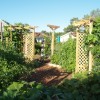 Although design basics for edible ornamental landscapes are essentially the same as strictly ornamental landscapes, a few details ensure the success of the edible landscape. Gardens with plants that change considerably with the seasons rely more on an organized yet interesting layout, appealing support structures, functional pathways, and colorful containers and planters to provide interest and beauty when the plants are not taking center stage. There are twelve important ideas to consider when creating a successful edible ornamental garden. This 4-page fact sheet was written by Gail Hansen, and published by the UF Department of Environmental Horticulture, May 2013.
Although design basics for edible ornamental landscapes are essentially the same as strictly ornamental landscapes, a few details ensure the success of the edible landscape. Gardens with plants that change considerably with the seasons rely more on an organized yet interesting layout, appealing support structures, functional pathways, and colorful containers and planters to provide interest and beauty when the plants are not taking center stage. There are twelve important ideas to consider when creating a successful edible ornamental garden. This 4-page fact sheet was written by Gail Hansen, and published by the UF Department of Environmental Horticulture, May 2013.
http://edis.ifas.ufl.edu/ep475
Design and Implementation of Edible Plant Demonstration Gardens: A Case Study of the Putnam County Extension Edible Garden (ENH1205/EP466)
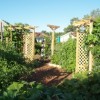 Demonstration gardens are a collection of plants assembled and organized in a manner that allows garden visitors to access and study them. Most gardens are designed with a particular focus and include plants that support the purpose and educational theme of the garden. This case study features an edible plant demonstration garden that was designed and installed in Hastings, Florida, on the Extension office grounds. The UF/IFAS program and the Partnership for Water, Agriculture, and Community Sustainability (FPWACS) designed and implemented the demonstration garden using a step-by-step process that is discussed in this 15-page fact sheet written by Gail Hansen, Joseph Sewards, Rebecca Almeida, and Andrew Dunn, and published by the UF Department of Environmental Horticulture, November 2012.
Demonstration gardens are a collection of plants assembled and organized in a manner that allows garden visitors to access and study them. Most gardens are designed with a particular focus and include plants that support the purpose and educational theme of the garden. This case study features an edible plant demonstration garden that was designed and installed in Hastings, Florida, on the Extension office grounds. The UF/IFAS program and the Partnership for Water, Agriculture, and Community Sustainability (FPWACS) designed and implemented the demonstration garden using a step-by-step process that is discussed in this 15-page fact sheet written by Gail Hansen, Joseph Sewards, Rebecca Almeida, and Andrew Dunn, and published by the UF Department of Environmental Horticulture, November 2012.
http://edis.ifas.ufl.edu/ep466
Design Considerations for a Florida-Friendly Demonstration Landscape: A Case Study for Student and Extension Volunteer Involvement (ENH1199/EP460)
 Landscape design students in the Environmental Horticulture Department at the University of Florida participated in the planning and design of the landscape for a new professional development center on the university campus. Such large-scale projects provide a unique experiential learning activity for students and volunteers in landscape design and horticulture programs. This 6-page fact sheet was written by Gail Hansen and Brian Niemann, and published by the UF Department of Environmental Horticulture, August 2012.
Landscape design students in the Environmental Horticulture Department at the University of Florida participated in the planning and design of the landscape for a new professional development center on the university campus. Such large-scale projects provide a unique experiential learning activity for students and volunteers in landscape design and horticulture programs. This 6-page fact sheet was written by Gail Hansen and Brian Niemann, and published by the UF Department of Environmental Horticulture, August 2012.
http://edis.ifas.ufl.edu/ep460
Landscape Design: Drawing a Planting Plan (ENH1195/EP456)
 Selecting and placing plants in the landscape is the art and science of arranging plant material to make a healthy, functional, and beautiful yard. The mix of science and art is expressed in the guiding principle of “right plant, right place,” meaning to select plants that can thrive in the growing conditions of the site and locating them for both visual appeal and health. Selecting and arranging plants are the last steps in the overall design process after the site analysis is complete and the activity areas located and designed.Developing the planting plan is a sequential process, but it is important to remember that the process is not completely linear; sometimes decisions about plant material require reworking previous steps in the sequence and making adjustments to the plan. This 10-page fact sheet was written by Gail Hansen, and published by the UF Department of Environmental Horticulture, January 2012.
Selecting and placing plants in the landscape is the art and science of arranging plant material to make a healthy, functional, and beautiful yard. The mix of science and art is expressed in the guiding principle of “right plant, right place,” meaning to select plants that can thrive in the growing conditions of the site and locating them for both visual appeal and health. Selecting and arranging plants are the last steps in the overall design process after the site analysis is complete and the activity areas located and designed.Developing the planting plan is a sequential process, but it is important to remember that the process is not completely linear; sometimes decisions about plant material require reworking previous steps in the sequence and making adjustments to the plan. This 10-page fact sheet was written by Gail Hansen, and published by the UF Department of Environmental Horticulture, January 2012.
http://edis.ifas.ufl.edu/ep456
Landscape Design: Arranging Plants in the Landscape (ENH1188/EP449)
 In nature, plants grow in clusters and drifts, extending to overlap and interlock in layers as they merge with each other. In a planned landscape, use similar patterns to arrange plants, using layers and repetition. Learn more in this 4-page fact sheet written by Gail Hansen, and published by the UF Department of Environmental Horticulture, October 2011.
In nature, plants grow in clusters and drifts, extending to overlap and interlock in layers as they merge with each other. In a planned landscape, use similar patterns to arrange plants, using layers and repetition. Learn more in this 4-page fact sheet written by Gail Hansen, and published by the UF Department of Environmental Horticulture, October 2011.
http://edis.ifas.ufl.edu/ep449
Florida-Friendly Landscaping™ Pattern Book: Sample plant lists and designs for four Florida regions
These pattern books were written by Gail Hansen, Kelly Perez, and Esen Momol, and published by the UF Department of Environmental Horticulture, January 2011. They provide homeowners with design guidelines and suggested plants for typical residential site conditions in the following 4 USDA hardiness zones in Florida:
USDA Hardiness Zones 8A and 8B, North Florida (ENH1175/EP436)
http://edis.ifas.ufl.edu/ep436
USDA Hardiness Zone 9A, North Central Florida (ENH1176/EP437)
http://edis.ifas.ufl.edu/ep437
USDA Hardiness Zone 9B, South Central Florida (ENH1177/EP438)
http://edis.ifas.ufl.edu/ep438
USDA Hardiness Zones 10A, 10B, and 11, South Florida (ENH1178/EP439)
http://edis.ifas.ufl.edu/ep439
Twenty-Two Ideas for a Low-Care, Low-Cost Landscape (ENH1181/EP442)
Many homeowners desire a beautiful landscape but are often discouraged by the lack of time and money needed to create and care for the garden of their dreams. A pleasing, low-care, low-cost landscape is possible, however, with careful planning, appropriate plant choices, and thoughtful design. This 11-page fact sheet was written by Gail Hansen, and published by the UF Department of Environmental Horticulture, April 2011.
http://edis.ifas.ufl.edu/ep442
Questions and Answers: 2009 Florida-Friendly Landscaping™ Legislation (ENH1179/EP440)
Florida’s increasing urbanization, coastal development, and population growth continue to tax water resources. Homeowners’ association (HOA) covenants governing landscape design and maintenance can have a significant, adverse impact on the environment, but by encouraging the transformation of conventional landscapes to Florida-Friendly landscapes, HOAs and homeowners can conserve water, protect the environment, and allow a wide range of aesthetic choices. This 10-page fact sheet answers questions HOAs and homeowners may have about the implications of Florida Statute § 373.185 for HOA review boards. It also addresses the aesthetics of Florida-Friendly Landscaping™ and provides a list of resources for further information. It was written by Kathy Malone, Esen Momol, Jane Tolbert, Marina D’Abreau, Terril Nell, Gail Hansen, Gary Knox, Michael Thomas, Kristine Jones, and Jim Spratt, and published by the UF Department of Environmental Horticulture, March 2011.
http://edis.ifas.ufl.edu/ep440
ENH1172/EP433 Landscape Design: Aesthetic Characteristics of Plants
ENH1172, an 8-page illustrated fact sheet by Gail Hansen and Erin Alvarez, discusses form, texture, size and color of landscape plants and how to choose plant combinations based on these qualities to create a composition of plant material. Includes references. Published by the UF Department of Environmental Horticulture, September 2010.
http://edis.ifas.ufl.edu/ep433
ENH1160/EP420 Community ButterflyScaping: How to Move Beyond Butterfly Gardening to Create a Large-Scale Butterfly Habitat
ENH1160, a 20-page illustrated fact sheet by Kathy C. Malone, Wendy Wilber, Gail Hansen, Jaret C. Daniels, Claudia Larsen, and Esen Momol, provides developers, community associations, and homeowners with guidance in planning the vegetation in common areas, stormwater management systems, undeveloped areas, and yards to form large-scale habitats attractive to butterflies, pollinators, birds, and other local wildlife. Includes references. Published by the UF Department of Environmental Horticulture, Spetember 2010.
http://edis.ifas.ufl.edu/ep420
ENH1171/EP432 Arbor, Trellis, or Pergola—What’s in Your Garden: A Mini-Dictionary of Garden Structures and Plant Forms
ENH1171, a 7-page fact sheet by Gail Hansen, provides definitions and information about the origins of garden structures for people, garden ornaments, structures for animals, and plant forms. Includes references. Published by the UF Department of Environmental Horticulture, August 2010.
http://edis.ifas.ufl.edu/ep432
ENH1169/EP430 Landscape Design: Finding Inspiration for a Design Theme
ENH1169, a 4-page illustrated fact sheet by Gail Hansen and Erin Alvarez, suggests types of design themes, sources of inspiration, and how to incorporate a theme into a landscape design. Includes references. Published by the UF Department of Environmental Horticulture, July 2010.
http://edis.ifas.ufl.edu/ep430
CIR536/MG086 Basic Principles of Landscape Design
Revised! Circular 536, a 12-page illustrated circular by Gail Hansen, explains the design process that landscape designers use, that systematically considers all aspects of the land, the environment, the growing plants, and the needs of the user to ensure a visually pleasing, functional, and ecologically healthy design. Published by the UF Department of Environmental Horticulture, July 2010.
http://edis.ifas.ufl.edu/mg086
ENH1166/EP427 Landscape Design: Putting Your Yard on Paper — Site Measurements and Base Maps
ENH1166, a 5-page illustrated fact sheet by Gail Hansen and Erin Alvarez, discusses how to draw a base map using a legal site survey in order to plan a design for your yard’s landscape. Includes advice on taking measurements and tips for drawing a base map. Published by the UF Department of Environmental Horticulture, June 2010.
http://edis.ifas.ufl.edu/ep427
